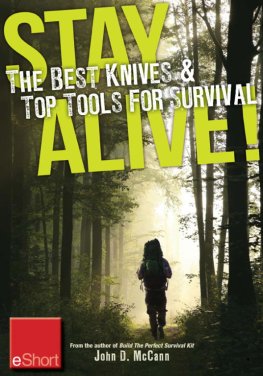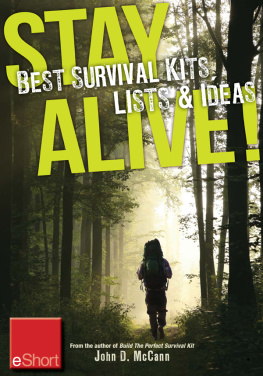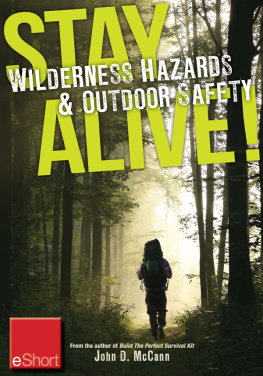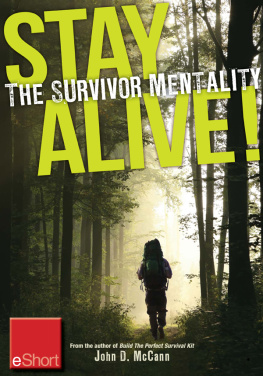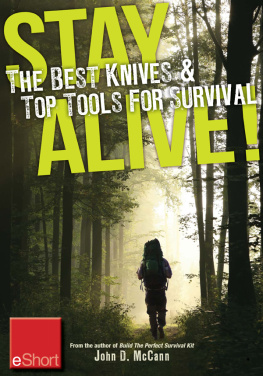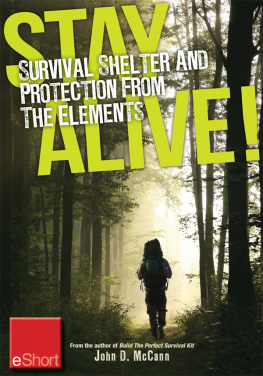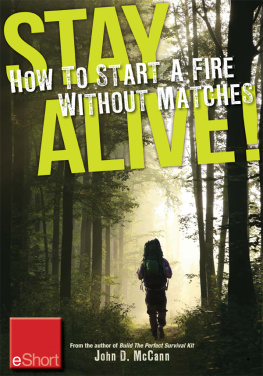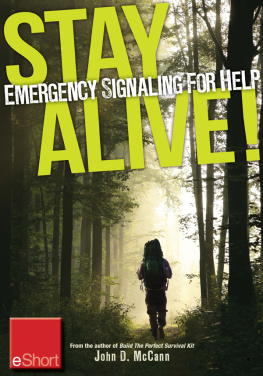McCann - Stay Alive - Wilderness Hazards & Outdoor Safety eShort
Here you can read online McCann - Stay Alive - Wilderness Hazards & Outdoor Safety eShort full text of the book (entire story) in english for free. Download pdf and epub, get meaning, cover and reviews about this ebook. City: Iola, WI, year: 2012, publisher: Krause Publications, genre: Home and family. Description of the work, (preface) as well as reviews are available. Best literature library LitArk.com created for fans of good reading and offers a wide selection of genres:
Romance novel
Science fiction
Adventure
Detective
Science
History
Home and family
Prose
Art
Politics
Computer
Non-fiction
Religion
Business
Children
Humor
Choose a favorite category and find really read worthwhile books. Enjoy immersion in the world of imagination, feel the emotions of the characters or learn something new for yourself, make an fascinating discovery.
- Book:Stay Alive - Wilderness Hazards & Outdoor Safety eShort
- Author:
- Publisher:Krause Publications
- Genre:
- Year:2012
- City:Iola, WI
- Rating:4 / 5
- Favourites:Add to favourites
- Your mark:
- 80
- 1
- 2
- 3
- 4
- 5
Stay Alive - Wilderness Hazards & Outdoor Safety eShort: summary, description and annotation
We offer to read an annotation, description, summary or preface (depends on what the author of the book "Stay Alive - Wilderness Hazards & Outdoor Safety eShort" wrote himself). If you haven't found the necessary information about the book — write in the comments, we will try to find it.
Abstract: In this excerpt from Stay Alive! Survival Skills You Need, John D. McCann informs you of dangers, hazards and medical issues that you may encounter in a survival situation
McCann: author's other books
Who wrote Stay Alive - Wilderness Hazards & Outdoor Safety eShort? Find out the surname, the name of the author of the book and a list of all author's works by series.
Stay Alive - Wilderness Hazards & Outdoor Safety eShort — read online for free the complete book (whole text) full work
Below is the text of the book, divided by pages. System saving the place of the last page read, allows you to conveniently read the book "Stay Alive - Wilderness Hazards & Outdoor Safety eShort" online for free, without having to search again every time where you left off. Put a bookmark, and you can go to the page where you finished reading at any time.
Font size:
Interval:
Bookmark:


Many people are killed by lightning while participating in outdoor activities. Avoid the base of trees and water if lightning occurs. In an open field, insulate yourself from the ground by sitting on your pack. (iStockphoto.com/dimabl)
Survival skills keep you alive and get you back home safely. But while you are out there trying to survive, many hazards might befall you that can make your situation worse. There are also health, medical, and safety issues that might need to be addressed to ensure you return in one piece. Lets look at some of these issues.
Weather
Weather can present a major hazard in a survival situation. Thunderstorms can be dangerous: lightning can kill. The two major hazardous areas during a lightning storm are the base of lone standing trees, open fields and open water. If the lightning starts, keep away from both.
Storms can also cause flashfloods, which is one of the reasons you dont build a shelter in a run-off area. Storms can also make you wet, and with wind, can cause a hypothermic situation.
Extreme cold and wind chill can rob your body of heat. Extreme heat can cause heat related injuries from hyperthermia. Keep an eye on the weather. Dont let mother nature throw you a curve.
Carbon monoxide
Carbon monoxide is a danger when you have a fire in an enclosed space. This includes a vehicle, cabin, tent or even a survival shelter. Where there is combustion, even just a candle burning, make sure you have a source of fresh air. Oftentimes in a survival situation, survivors become so concerned with keeping the cold out that they forget about ventilation.
Carbon monoxide is an odorless, tasteless, colorless gas that is known as the silent killer. It is produced by burning material containing carbon. Carbon monoxide poisoning can cause brain damage and death. You cant see it, smell it, or taste it, but carbon monoxide can kill you.
Early symptoms of carbon monoxide poisoning, such as headaches, nausea, and fatigue, are often mistaken for the flu because the deadly gas goes undetected. However, it usually gives no warning (although if you see a small flame, like a candle, start to burn poorly, it should alert you to a lack of oxygen, which means lack of ventilation).
When you are in a small area, such as a shelter, make sure you maintain good ventilation if you have a flame present. You may not be as warm as you would like, but you will be alive in the morning.

With MARSARS Ice Awls, the plastic shroud retracts into the handle to reveal the metal awls. The Ice Awls come with an attached cord and a belt pouch.
Crossing ice
Traveling on or near ice is always dangerous. If possible, avoid it. If you must cross over it, use extreme caution. Try to check how solid it is if you can do so safely. If you must pass over ice, carry a stout pole. Use it to test the ice in front of you. If you fall through, you can also use the pole as a bridge across the hole to keep you from being completely submerged in the water. You can also use a knife, or whatever you have, to dig into the ice to help pull yourself out.
If you know you will be near ice, you should carry ice awls. They were designed so, if you fall through the ice, they become a self-rescue device that allows you to pull yourself onto and across unstable ice. The ice awls have a metal pick in each handle. The awls (picks) are surrounded by plastic shrouds which retract into the handles each time the handles are pressed into the ice. They are made by MARSARS Water Rescue Systems, Inc. (www.icerescue.marsars.com), and come in a cordura belt pouch, so they are on you when you need them. I have had a pair for years and they are in my winter survival kit.

Water crossings are always potentially dangerous. Your best bet may be to find another place to safely cross.(iStockphoto.com/Adventure_photo)
Crossing water
Crossing water can be another hazardous activity. The first thing you should do is make sure this is what you need to do. Is it absolutely necessary? Check around (if you have a map use it) and make sure there is not a bridge over the water in the vicinity. Is there a large log which can be used for crossing? Always look for an alternative to actually getting in the water.
If you must cross, look for the best place to cross. Always assume there are hidden dangers, even if the water appears slow moving and calm. Even though water appears clear, there may be obstacles you cant see.
Begin by studying the character of the water in order to determine the best possible place to cross. If you can, try to cross between bends, and not at bends, as water flows the fastest at the outside of bends. Slow moving water is usually deeper than fast water, but can contain hazards such as weeds, mud, rocks or other hidden obstacles. Avoid areas where the bank is undercut, as it will make it difficult to climb back on shore. Also avoid any debris that could entangle you. The choice is not always easy, but give it some thought before you wade in.
There are various ways to cross water, but when alone, make sure you have a stout pole. Wear footwear even if you must later dry it out. You dont want a cut or broken foot, and you will need a firm footing. If you are wearing a pack, make sure you disconnect the waist strap and loosen the straps. If you fall in, you want to be able to get rid of the pack quickly so it doesnt pull you under.
As you cross, face upstream and use the pole as a third leg, leaning into the pole. This makes you a tripod and more steady. While leaning toward the pole, slowly move one foot sideways across the current, being careful not to let the current force your leg backwards. Slide the foot, dont lift it. When it is securely back down and steady, move the next foot in the same manner. Move at an angle downstream, although you are facing upstream. This way you are not fighting the current as much as if you were trying to move into it.
If you do fall into the water, try to stay on your back with your feet facing downstream. Try to keep your toes up out of the water so your feet dont get snagged on anything, and steer yourself towards a shore.

You dont want to tangle with these guys! (iStockphoto.com/gbrundin)
There are many animals, snakes, etc. in the outdoors. Especially in a survival situation, be cautious of the hazards involved. Dont take chances with any animal; avoidance is the safest bet.
There is a lot of information available for dealing with bears in the outdoors, so I advise you to do some further research in regard to the subject. Some basics are, normally, if you dont bother them, they wont bother you (but there are no guarantees). Dont surprise a bear and NEVER get between a mother and her cubs. Make noise when in bear country to avoid surprising them. Talk, whistle, sing, carry a cup and spoon dangling from a pack, or even some stones in a can. Make sure they can hear you coming. Dont keep food in or near your shelter or camp, as it will attract them.
Font size:
Interval:
Bookmark:
Similar books «Stay Alive - Wilderness Hazards & Outdoor Safety eShort»
Look at similar books to Stay Alive - Wilderness Hazards & Outdoor Safety eShort. We have selected literature similar in name and meaning in the hope of providing readers with more options to find new, interesting, not yet read works.
Discussion, reviews of the book Stay Alive - Wilderness Hazards & Outdoor Safety eShort and just readers' own opinions. Leave your comments, write what you think about the work, its meaning or the main characters. Specify what exactly you liked and what you didn't like, and why you think so.







